Gujarat Board GSEB Textbook Solutions Class 6 Maths Chapter 7 Fractions Ex 7.4 Textbook Questions and Answers.
Gujarat Board Textbook Solutions Class 6 Maths Chapter 7 Fractions Ex 7.4
Question 1.
Write shaded portion as fraction. Arrange them in ascending and descending order using correct sign ‘<‘, ‘=’ ‘>’between the fractions:
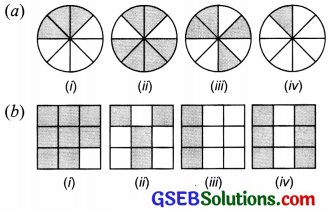
(c) (i) show \(\frac { 2 }{ 6 } \), \(\frac { 4 }{ 6 } \), \(\frac { 8 }{ 6 } \) and \(\frac { 8 }{ 6 } \) on the number line.
(ii) Put appropriate signs between the fractions given.

Solution:
(a) Figure (i) represents fraction = \(\frac { 3 }{ 8 } \)
Figure (ii) represents fraction = \(\frac { 6 }{ 8 } \)
Figure (iii) represents fraction = \(\frac { 4 }{ 8 } \)
Figure (iv) represents fraction = \(\frac { 1 }{ 8 } \)
These are like fractions. So we arrange them in order to their numerators.
Ascending order: \(\frac { 1 }{ 8 } \) < \(\frac { 3 }{ 8 } \) < \(\frac { 4 }{ 8 } \) < \(\frac { 6 }{ 8 } \) Descending order: \(\frac { 6 }{ 8 } \) > \(\frac { 4 }{ 8 } \) > \(\frac { 3 }{ 8 } \) > \(\frac { 1 }{ 8 } \)
(b) Figure (i) represents a fraction = \(\frac { 8 }{ 9 } \)
Figure (ii) represents a fraction = \(\frac { 4 }{ 9 } \)
Figure (iii) represents a fraction = \(\frac { 3 }{ 9 } \)
Figure (iv) represents a fraction = \(\frac { 6 }{ 9 } \)
The fractions are like fractions with different numerators.
Ascending order: \(\frac { 3 }{ 9 } \)< \(\frac { 4 }{ 9 } \) < \(\frac { 6 }{ 9 } \) < \(\frac { 8 }{ 9 } \) Descending order: \(\frac { 8 }{ 9 } \) > \(\frac { 6 }{ 9 } \) > \(\frac { 4 }{ 9 } \) > \(\frac { 3 }{ 9 } \)
(c) (i) Given fractions are: \(\frac { 2 }{ 6 } \), \(\frac { 4 }{ 6 } \), \(\frac { 8 }{ 6 } \) and \(\frac { 6 }{ 6 } \)
We can have: \(\frac { 2 }{ 6 } \) < \(\frac { 4 }{ 6 } \) < \(\frac { 8 }{ 6 } \) < \(\frac { 6 }{ 6 } \)

(ii) We have: \(\frac { 5 }{ 6 } \) > \(\frac { 2 }{ 6 } \); \(\frac { 3 }{ 6 } \) > 0
\(\frac { 6 }{ 6 } \) < \(\frac { 1 }{ 6 } \); \(\frac { 8 }{ 6 } \) < \(\frac { 5 }{ 6 } \)
![]()
Question 2.
Compare the fractions and put an appropriate sign.
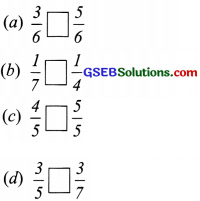
Solution:
(a) Here, we have ‘like fractions’ so we compare them by their numerators only.
![]()
(b) Here, we have ‘unlike fractions’ with same numerators, so we compare them with their denominators only.
![]()
(c) Like fractions, so we compare by their numerators only.
![]()
(d) ‘Unlike fractions’ with same numerators so we compare them by their denominators, only.
![]()
![]()
Question 3.
Make five more such pairs and put appropriate signs.
Solution:
Five more examples can be given as below:
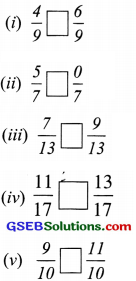
After writing the appropriate signs, we have:
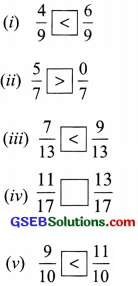
![]()
Question 4.
Look at the figures and write ‘<‘ ‘>’or ‘=’ between the given pairs of fractions.
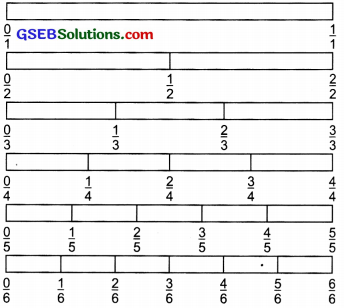
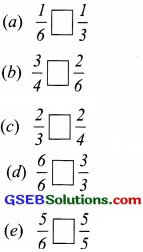
Make five more such problems and solve them with your friends.
Solution:
(a) In the figure, \(\frac { 1 }{ 6 } \) is on the left of \(\frac { 1 }{ 3 } \)

(b) In the figure, \(\frac { 3 }{ 4 } \) lies on the right of \(\frac { 2 }{ 6 } \).
![]()
(c) In the figure, \(\frac { 2 }{ 3 } \) is on the right of \(\frac { 2 }{ 4 } \)
![]()
(d) In the figurc, \(\frac { 6 }{ 6 } \) is on the same point as of \(\frac { 3 }{ 3 } \).
![]()
(e) In the figure, \(\frac { 5 }{ 6 } \) is at the same point as \(\frac { 5 }{ 5 } \).
![]()
Five more examples can be given as below:
Look at the previous figure and write ‘<‘, ‘>‘
or ‘=’ between the following pairs of fractions:
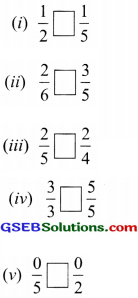
After writing the appropriate signs, we have

![]()
Question 5.
How quickly can you do this? Fill appropriate sign. (‘<‘, ‘=’, ‘>’)
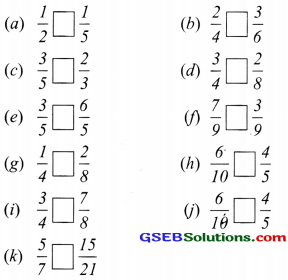
Solution:
We use cross-product method for quicker calculations.
We have
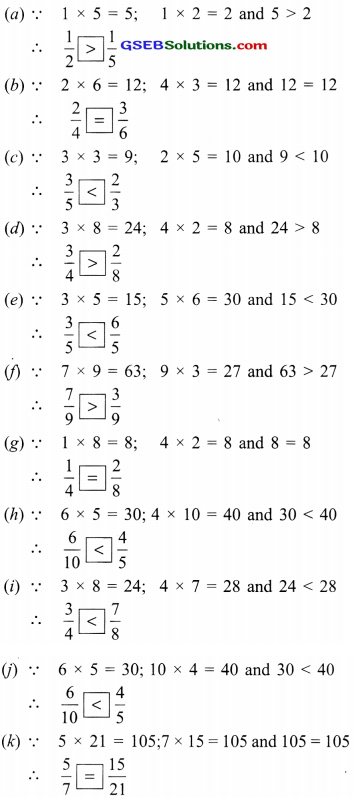
![]()
Question 6.
The following fractions represent just three different numbers. Separate them into three groups of equivalent fi-actions, by changing each one to its simplest form.
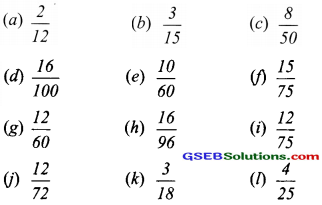
Solution:

Grouping the simplest forms, we have:
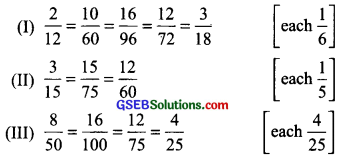
![]()
Question 7.
Find answers to the following. Write and indicare how you solved them,
(a) Is \(\frac { 5 }{ 9 } \) equal to \(\frac { 4 }{ 5 } \) ?
(b) Is \(\frac { 9 }{ 16 } \) equal to \(\frac { 5 }{ 9 } \) ?
(c) Is \(\frac { 4 }{ 5 } \) equal to \(\frac { 16 }{ 20 } \) ?
(d) Is \(\frac { 1 }{ 15 } \) equal to \(\frac { 4 }{ 30 } \) ?
Solution:
(a) By cross product, we have
5 x 5 = 25 and 9 x 4 = 36
25 ≠ 36 i.e 5 x 5 ≠ 9 x 4
\(\frac { 5 }{ 9 } \) ≠ \(\frac { 4 }{ 5 } \) i.e \(\frac { 5 }{ 9 } \), is not equal to \(\frac { 2 }{ 7 } \).
(b) y cross product, we have
9 x 9 = 81 and 16 x 5 = 80
81 ≠ 80,i.e.9 x 9 ≠ 16 x 5
\(\frac { 9 }{ 16 } \) ≠ \(\frac { 5 }{ 9 } \), i.e. \(\frac { 9 }{ 16 } \) is not equal to \(\frac { 5 }{ 9 } \).
(c) By cross product, we have
4 x 20 = 80 and 5 x 16 = 80
4 x 20 = 5 x 16
\(\frac { 4 }{ 5 } \) = \(\frac { 16 }{ 20 } \), i.e. \(\frac { 16 }{ 20 } \) and \(\frac { 4 }{ 5 } \) are equal.
(d) By cross product, we have
1 x 30 = 30 and 4 x 15 = 60
30 ≠ 60, i.e. 1 x 30 ≠ 4 x 15
\(\frac { 1 }{ 5 } \) ≠ \(\frac { 4 }{ 30 } \)
![]()
Question 8.
Ila read 25 pages of a book containing 100 pages. Lauta read \(\frac { 2 }{ 5 } \) of the same book. Who read less?
Solution:
Fraction of book read by Illa = \(\frac { 25 }{ 100 } \)
\(\frac{25 \div 25}{100 \div 25}\) = \(\frac { 1 }{ 4 } \)
Fraction of book read by Lauta = \(\frac { 2 }{ 5 } \)
To compare \(\frac { 1 }{ 4 } \) and \(\frac { 2 }{ 5 } \) we have, 1 x 5 = 5;
4 x 2 = 8 and 5 < 8
\(\frac { 1 }{ 4 } \) < \(\frac { 2 }{ 5 } \) Thus Ila read less. Question 9. Rafiq exercised for \(\frac { 3 }{ 6 } \) of an hour, while Rohit exercised for \(\frac { 3 }{ 4 } \) of an hour Who exercised for a longer time? Solution: Fraction of an hour for which Rafiq exercised = \(\frac { 3 }{ 6 } \) Fraction of an hour for which Rohit exercised = \(\frac { 3 }{ 4 } \) To compare \(\frac { 3 }{ 6 } \) and \(\frac { 3 }{ 4 } \) we have: For ‘unlike fractions’ with same numerator, greator fraction has lesser denominator. \(\frac { 3 }{ 4 } \) > \(\frac { 3 }{ 6 } \)
Rohit exercised for a longer period.
![]()
Question 10.
In a class A of 25 students, 20 passed in first class; in another class B of 30 students, 24 passed in first class. In which class was a greater fraction of students getting first class?
Solution:
In class A, fraction of students who got 1st division
= \(\frac { 20 }{ 25 } \) = \(\frac{20+5}{25 \div 5}\) = \(\frac { 4 }{ 5 } \) ………….(i)
In class B, fraction of students who got 1st division
\(\frac { 24 }{ 25 } \) = \(\frac{24 \div 6}{30 \div 6}\) = \(\frac { 4 }{ 5 } \) ……………..(ii)
From (i) and (ii), same fraction \(\left(\frac{4}{5}\right)\) of students got 1st class in both the classes.